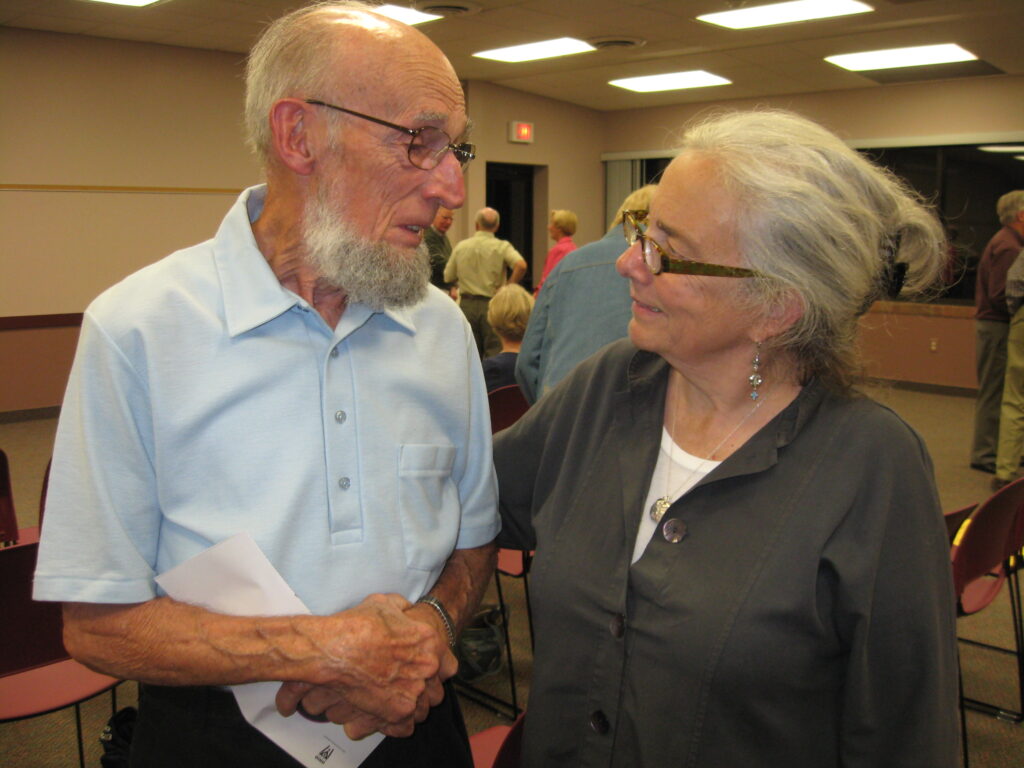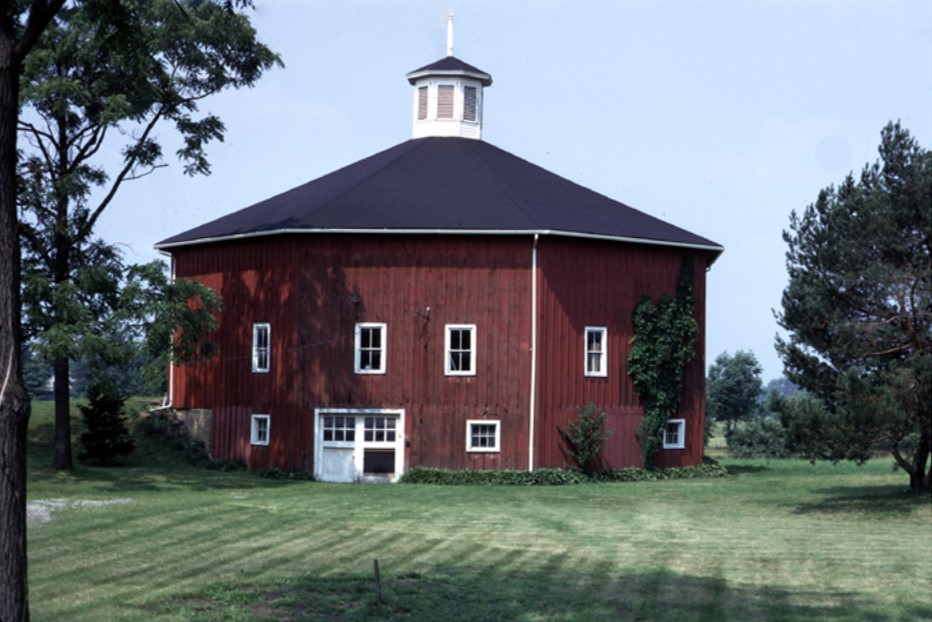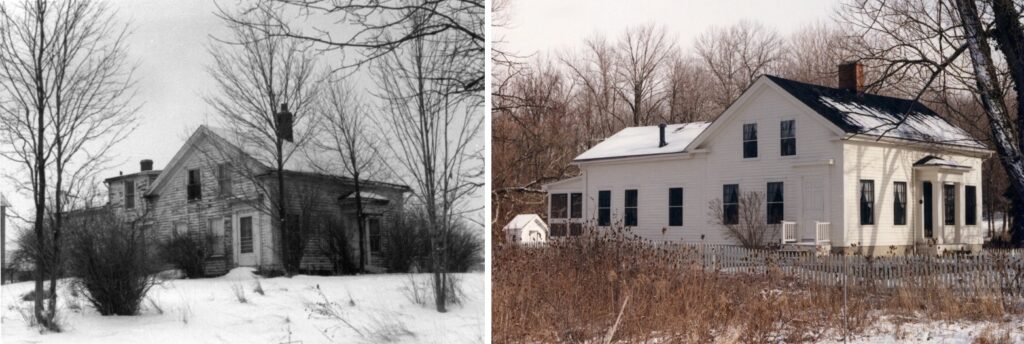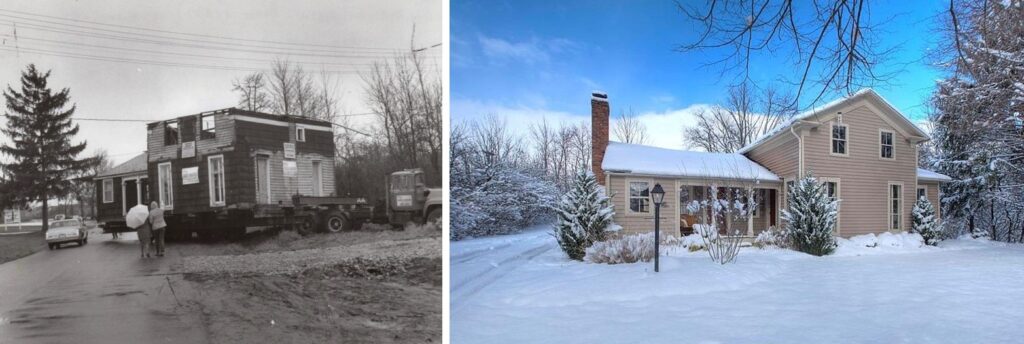Thurs, Nov 13, 7:00pm at Barlow Community Center. Dr. Megan Shaeffer discusses the history and archaeology of Wood Hollow Metro Park
Remembering Donald P. Reisig, Renowned Historic Restoration Contractor

Don Reisig and Katie Coulton, former owner of the Grey Colt and HHA board member, speaking after an October 2013 HHA Program honoring Don and his preservation work.
In an age of “house flipping” and “tear-down” culture, you might be hard-pressed to find a contractor-preservationist with an interest and passion for historic preservation, who is also a master craftsman capable of overseeing every detail of a restoration project, from house moving, masonry, framing, carpentry, finishing and to the making of furniture and cabinetry. A rare breed indeed!
Don Reisig was one such contractor who, for close to five-decades, dedicated his life to restoring and preserving the architectural heritage of the Western Reserve. Don died on November 17, 2020, in Tallmadge, OH, where he lived most of his life. He was 88-years old.
Reisig restored over 100 historic structures in the Ohio Western Reserve, many of which are on the National Register of Historic Places. He will be remembered for his tireless collaborations with Hudson Heritage Association, his great contributions to Hudson, and the restoration and preservation of many of the town’s historic structures.

1881 Hial and Milton C. Danforth Octagonal Barn prior to renovation.
Reisig first began working in Hudson in 1976, when the 1881 Hial and Milton C. Danforth Barn at 5100 Darrow Road, was renovated for commercial use as the company headquarters of The Smithers Company. Both Don Reisig and Allan Sveda, a Hudson architect, were hired by Smithers to undertake the barn restoration project. In an October 2013 HHA Program titled “HHA Honors Don Reisig & His Preservation Work”, Ginger Rogers, former board member and president of HHA and long-time member of the Architectural & Historic Board of Review (AHBR), affectionately reflected on the Octagonal Barn renovation – “Don was always appreciative and respectful of the craftsmanship of these historic structures. He would endeavor to show it off and do his work in harmony with it.”
By the 1980s, Hudson saw a dramatic transformation and expansion. Hudson architect Charles D. Willets (1914-1993), one of the founding members of both HHA and the AHBR, and the restoration architect at Hale Farm & Village, warned that many of the smaller historic farmhouses in Hudson were in jeopardy, as developers bought-up hundreds of acres of farmland for new residential subdivisions. Fortunately, Don Reisig was there to restore some of these houses.

The Grissom farmhouse (1835 Chloe-Wright House) as it appeared at 2494 Hudson-Aurora Road (left), now the site of the Hudson High School. The house was saved and relocated to 63 Owen Brown Street in 1983.
For instance, the Grissom Farm at one time was a thriving 400-acre dairy farm until most of the land was sold to housing developers in 1961, to make way for Hudson Park Estates that would later obscure the horizon of Grissom’s rolling north pasture beyond Aurora Road. Grissom retained approximately 100 acres to raise 70 Black Angus cattle, but eventually this land became the 72-acre Hudson High School that opened in 1992, at the corner of Hudson-Aurora and Stow roads.
With perseverance, the assistance of the Hudson Heritage Association, and willing buyer Katie Coulton, the Grissom farmhouse (1835 Chloe-Wright House) and granary were rescued from threatened demolition and moved to 63 Owen Brown Street in the summer of 1983, where they were meticulously restored by Don Reisig.
Katie Coulton recalled the house move with Don, “On June 29, we met out at the farm for the move at 8:00 AM. Don and I followed behind the house in a pickup truck pulling the granary and by 10:30 we were on the Owen Brown site. We had to stop traffic at 91/303 and pick up a few branches along the way, but other than that, it went off without a hitch.”
The house was the first of five Greek Revival farmhouses located around the Hudson township that were destined for demolition by developers, and were moved, restored, and protected.

The 1837 Lyman Darrow House being moved to 65 Owen Brown Street in December 1987, where it would be meticulously restored by Don Reisig.
Reisig would also restore two other early Greek Revival houses that were moved to Owen Brown Street: the 1846 Harrison Danforth House and barn (moved in 1984) and the 1837 Lyman Darrow House at 65 Owen Brown (moved in 1987). The two homes were relocated from the corner of Norton Road and Darrow Road (RT 91) and once stood across the street from each other. Appropriately enough, they were reunited on Owen Brown Street. The 1843 Greek Revival brick house at 58 Owen Brown was also restored by Reisig. At the time the 1837 Lyman Darrow House was moved, Dorothy “Flit” Jones, an HHA member watching the moving operation, commented: “Pretty soon we’ll have to rename this street for Don Reisig because this is the fourth house he has worked on preserving.”
The 1835 Chloe-Wright House received one of the first six “Architectural Heritage Awards” to be presented by the Summit County Historical Society at a May 15, 1984 ceremony. The house tied with three other historic structures in the “Restoration” category, sharing the title with Hudson’s 1879 Town Hall restoration. The 1846 Harrison Danforth House also won the prestigious Architectural Heritage Award the following year in 1985, and the 1837 Lyman Darrow House in 1993.
In addition, Don’s many notable restoration projects in Hudson include: the 1806 David Hudson House at 318 N. Main St., the 1841 Porter-Holcomb House at 393 N. Main St., the 1846 Isaac Quay House at 38 Aurora St., the 1851 Bunnell-Read House at 20 Baldwin St., the 1854 John W. Smith House at 183 Aurora St., the 1878 Edwin S. Gregory House at 278 N. Main St., and the Village Green Bandstand (Gazebo).
A spare figure with a Lincoln-style beard, Donald P. Reisig was born in Cleveland on April 20, 1932. He met his wife, Joan, at West Technical High School and they were married on June 19, 1954, at St. Ignatius Church. He received his Journeymen Certificate in carpentry and cabinetmaking in 1956. After living in Lakewood, Don and Joan moved to Tallmadge in 1965, where they bought, restored, and lived with their two children in the Francis D. Alling House, an 1875 Victorian-style structure located at 323 East Avenue. The house was added to the National Register of Historic Places in 1987.
Reisig was head of the millwork division of Forest City Lumber in Cleveland for 23 years before starting his own business. It was through Hudson resident and HHA charter member, Edward Breedon, and his friendship with the Reisigs and Truexes of the Summit County Historical Society and the Tallmadge Historical Society, that Breedon was able to convince Don to leave Forest City Lumber and pursue work on restoration and preservation projects in Hudson. Concerned over the lack of interest in craftsmanship and preservation of old buildings, he started Reisig Restoration, Inc., his own fulltime carpentry business in 1974.
Reisig, a self-proclaimed historical buff, once said that “I’ve been interested in restoration ever since I was in high school. First, I was saving furniture. Now, I’m saving houses.”
Don and Joan were also friends and members of Hudson Heritage Association, recalls Tom Vince, WRA archivist, former board member and president of HHA, “but they did not have computer service at home, so they missed out on announcements when HHA went digital. I used to call them about meetings that I suspected they would want to attend.”
In September 2012, the Preservation Alliance of Greater Akron and the Summit County Historical Society of Akron, Ohio honored Don with a “Lifetime of Preservation Work Award”. The following month the City of Tallmadge honored Don with a Lifetime Achievement Award on November 8, 2012, “for his exemplary leadership and selfless acts of time and dedication to our community.”
This same declaration could describe Don’s life’s work and contributions to Hudson as well.
The HCTV recording of “HHA Honors Don Reisig & His Preservation Work: October 2013” can be viewed at: https://vimeo.com/332757341
Click here for the complete obituary: https://www.legacy.com/obituaries/ohio/obituary.aspx?n=donald-p-reisig&pid=197146372&fhid=5433
Editor’s Note: This article, written by Christopher Bach, originally appeared in the Hudson Heritage Association’s December Newsletter and is being reprinted here.